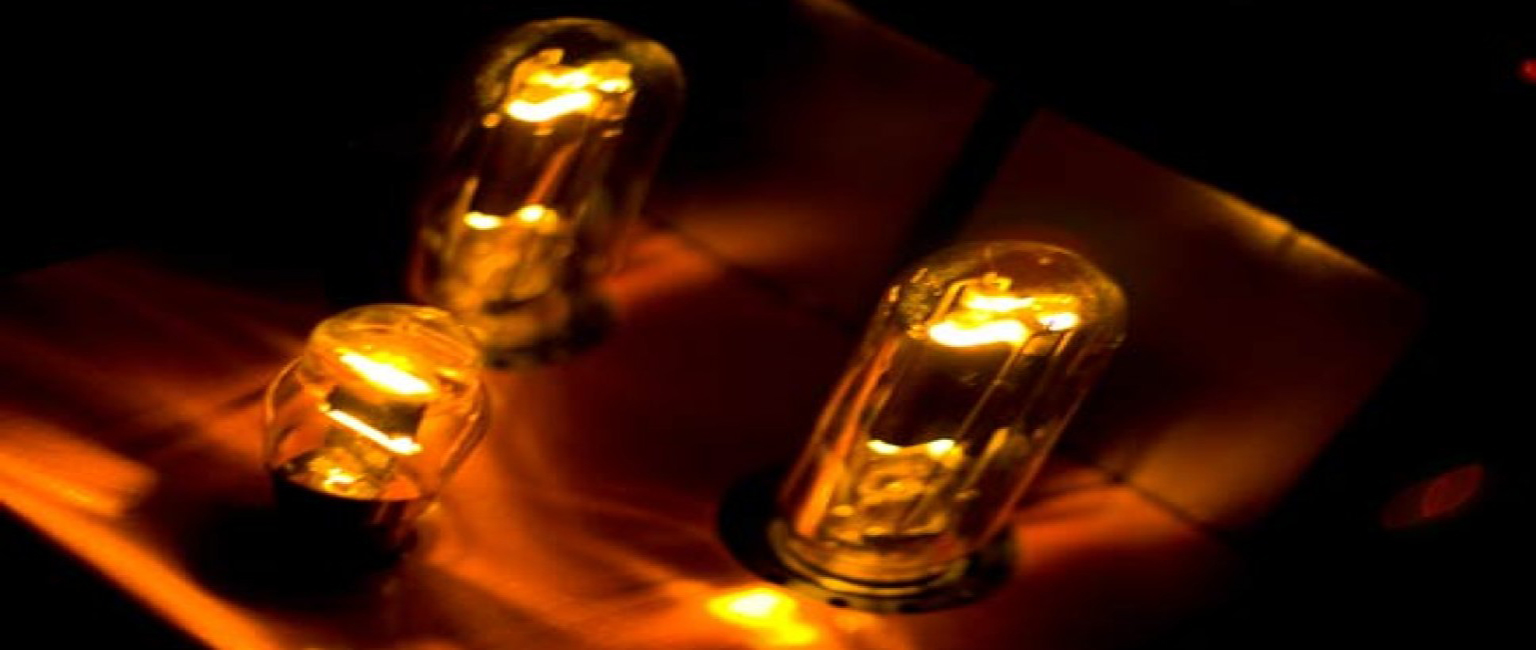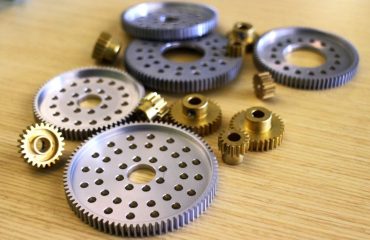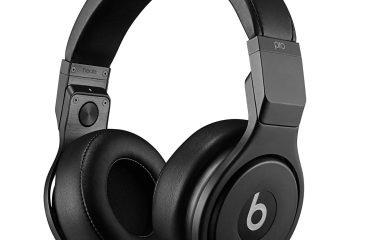The press preview day
We refer to it as Day Zero. Actually press activities begin a day earlier, on the 5th with an event called CES Unveiled. It features free food and drink (a magnet to journalists), but also the chance to meet exhibitors. Then the 6th is wall-to-wall press cons. Sorry, press conferences. “Press con” makes it sound too much like what a lot of them are.
 And even so, one speaker manufacturer managed to squeeze in a press con that began an hour before CES Unveiled. Polk is known for loudspeakers, but not so much for stage monitors like the HitMasters shown in the photo at left. But surprise, they’re not really stage monitors, and the journalist seated at the drum kit is not actually a musician. These self-powered speakers are meant to be hooked up to your TV when you play games such as RockBand or Guitar Hero. They’re $99 each, and we can imagine them selling in big quantities.
And even so, one speaker manufacturer managed to squeeze in a press con that began an hour before CES Unveiled. Polk is known for loudspeakers, but not so much for stage monitors like the HitMasters shown in the photo at left. But surprise, they’re not really stage monitors, and the journalist seated at the drum kit is not actually a musician. These self-powered speakers are meant to be hooked up to your TV when you play games such as RockBand or Guitar Hero. They’re $99 each, and we can imagine them selling in big quantities.
But now to CES Unveiled itself. This event used to be a showcase for the winners of the CES Innovation Awards. It has evolved into a commercial event, at which companies that may or may not be innovative pay money to have a table, so that they can meet the press, and perhaps even get on television. CES is thus competing directly with ShowStoppers, an almost identical event not organized by the association.
 The flashier exhibits get the most attention, predictably. In the picture at right, note all the TV cameras trained on the Quadricopter, an indoor remote-controlled model from Parrot. This nifty device very much upstaged a similar (but more primitive) series of flying toys from another company.
The flashier exhibits get the most attention, predictably. In the picture at right, note all the TV cameras trained on the Quadricopter, an indoor remote-controlled model from Parrot. This nifty device very much upstaged a similar (but more primitive) series of flying toys from another company.
One enigma: why did the electronics retailer Best Buy pay for a table at this event? A Best Buy rep told us the company was there in order to keep up with the latest so it could counsel its customers, but of course exhibiting wouldn’t seem especially helpful. To add to the enigma, Best Buy also paid to put its logo on attendee badge holders.
Another enigma: why did the HD Radio people pay for a table and then leave it empty? They’re the people who are barely skirting the fraud laws by using the HD initials, which usually refer to high definition, to apply to a US-only digital radio system that is actually extremely low definition. Perhaps they’re out of business, or is that too much to hope for?
We spotted only one actual hi-fi company at the event, namely Klipsch. Of course this huge, noisy hall is no place for even a low-fi demonstration. Klipsch was showing new efficient LED lighting units you can mount in your ceiling instead of halogen lights, and which can also — wait for it — play music! Meh.
We asked Logitech whether its newest Squeezeboxes could handle 24-bit/96 kHz music. Yes they can. Can we get one for a review? The answer: “We have a long waiting list.” Translation: no. Possible subtext: where’s Canada?
 The device at left is not really a candidate for our Kappa (home theatre) reference system, but how can you not love an LCD television that looks like this?
The device at left is not really a candidate for our Kappa (home theatre) reference system, but how can you not love an LCD television that looks like this?
We got a demo of Seagate’s new media player, which we’ll be talking more about in our next issue. You load up one of its small portable drives with media, which can include music and video, and transfer its contents to the player, which is permanently connected to your HDTV. It looks impressive, but we want to see some actual specs, since we know that “HD” doesn’t always mean “HD” (we did mention HD Radio, didn’t we?).
Two companies were showing 3-D video. The more impressive of the two was from Mitsubishi, which had brought a standard but particularly huge monitor, running with LCD-shutter glasses. Those glasses reduce brightness a little, but the results were stunning. Less slick was the demo from Canadian 3-D company Sensio, which used cardboard polarized glasses and a 3-D monitor of indistinguished resolution. You could even see scan lines, something you don’t expect from a modern TV set. Sensio is not just blowing smoke, however, and its technology is currently used for telecasting 3-D sporting events.
Several companies were showing devices for wireless recharging of devices like iPods and phones. No such device has the needed interface, though, which means the technology has to be built into, for instance, a carrying case. This could be a good idea whose time has not yet arrived.
The real “Day Zero” began Wednesday, bright and early. Like 8 am. Journalists who had gambled and partied all night were looking more than a little peak-eyed as the first conference, that of LG, began.
All the HDTV makers had the same story: sales were up, profits down, as both plasma and LCD became commoditized. Their way of salvation: LED backlighting (of course) and 3-D.
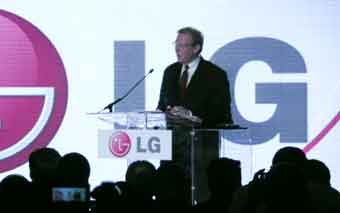 LG’s new Infinia series also offers wireless HDMI (thus saving a cable), but also Trumotion, running 480 images per second, or at least blinking the picture that fast. More interesting is a new network-attached storage (NAS) unit, a hard drive accessible to a whole network, with an integrated Blu-ray player. That would seem to have possibilities. But we’ve scheduled tours with both LG and Samsung, so we’ll be telling you more in a couple of days.
LG’s new Infinia series also offers wireless HDMI (thus saving a cable), but also Trumotion, running 480 images per second, or at least blinking the picture that fast. More interesting is a new network-attached storage (NAS) unit, a hard drive accessible to a whole network, with an integrated Blu-ray player. That would seem to have possibilities. But we’ve scheduled tours with both LG and Samsung, so we’ll be telling you more in a couple of days.
We were less enthusiastic about Toshiba and its new “Cell TV” system. It offers “True Super Resolution,” by inventing missing pixels (that’s a quote), and turning 2-D into 3-D on the fly. What’s next, perpetual motion?
Samsung, alas, also boasted of turning 2-D into 3-D (King Midas wold be impressed), though it had the honesty to admit that this was a mere stopgap solution to the lack of 3-D software. Bu it intends to do something about the software situation too, announcing a partnership with DreamWorks and Technicolor. The animated 3-D film Monsters vs Aliens will be a 3-D Blu-ray exclusive to Samsung.
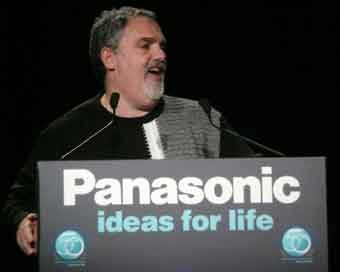 Panasonic had its own partnership to announce: DirecTV, the US satellite provider. To emphasize its determination to spur production of 3-D content, it invited John Landau, the producer of Avatar, who is shown at left. Samsung says that, in coming years, 3-D will be everywhere, and we will take it for granted the way we do color.
Panasonic had its own partnership to announce: DirecTV, the US satellite provider. To emphasize its determination to spur production of 3-D content, it invited John Landau, the producer of Avatar, who is shown at left. Samsung says that, in coming years, 3-D will be everywhere, and we will take it for granted the way we do color.
There was one more electronics giant with a press conference, namely Pioneer, but Pioneer astonished the press by talking only about its car systems. Of course it doesn’t make TV sets anymore, but it still makes Blu-ray player (we have one in our Kappa reference system) and various audio products.
We hear Sony had a press conference too, but we were persona non grata. Just as well. By then, we had taken about all the boasting we could handle for one day. Among them, the companies whose sessions we attended had collectively, if they are to be believed, 265% of the market.
The evening ended at a lively discotheque party thrown by Lenovo. We hid our MacBook Pro and had a terrific time.
Tomorrow…the high end exhibits at the Venetian. There are fewer of them than last year, but we should be able to stay busy and out of trouble.

